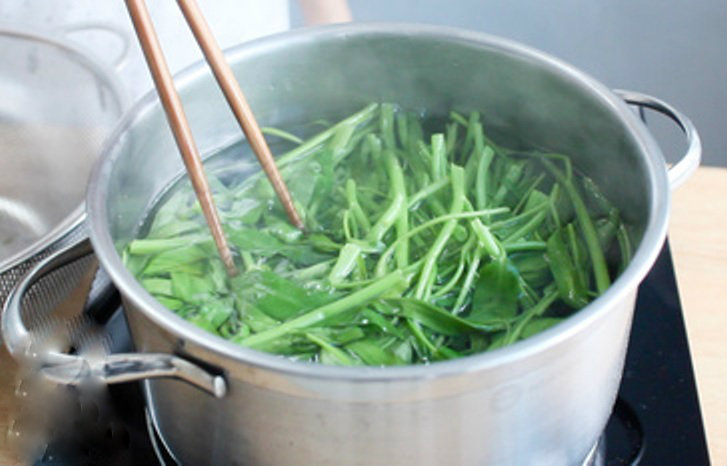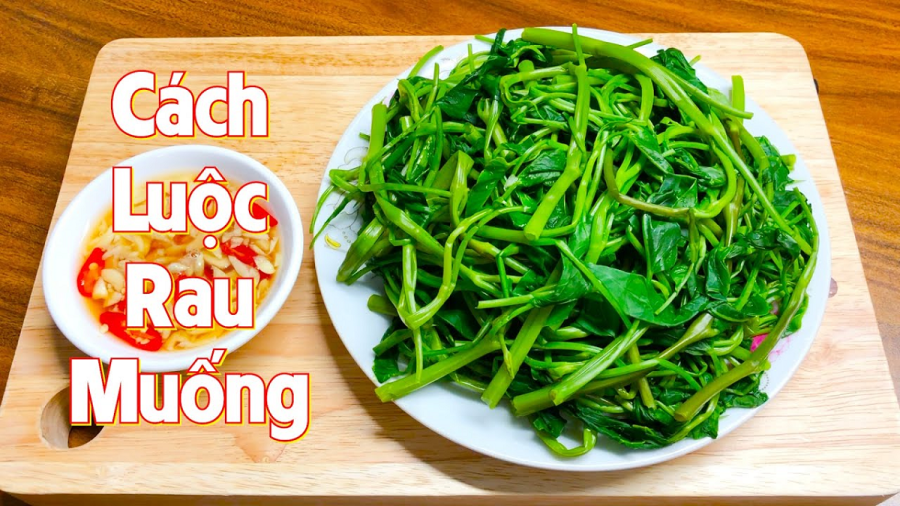Add salt to the pot of boiling water
Salt is one of the agents that helps increase the heat of the water, thereby minimizing the boiling time of the vegetables. Because of that, the boiled spinach is still evenly cooked, crispy and fresh, not mushy or red from being cooked for too long. Moreover, adding salt to the boiled spinach is also a way to make your family’s boiled vegetable plate more flavorful and appealing.
The reasonable amount of salt when boiling spinach is about 1/2 – 1 teaspoon of salt depending on the amount of water in the pot.

You should add salt to the water from the beginning and wait until the water boils before adding the spinach. When the spinach is cooked, take it out and put it in a bowl of cold water to retain its green color and ensure its crispiness.
Add vinegar/lemon juice to the pot of boiling water
When boiling spinach, adding a bit of vinegar or lemon juice will make the boiled vegetable plate greener and more visually appealing. Just use a little bit of vinegar/lemon juice to preserve the color of the vegetable without affecting its original taste.
The method is very simple, just add about 2 teaspoons of lemon juice or vinegar to the pot of boiling water and let it boil. When the water is boiling, add the spinach and take it out when it is fully cooked.
Boil spinach with plenty of water
In order to make the boiled spinach crispy and green, you need to submerge the vegetable in water and cook it until it is just cooked. If it is not fully cooked, the spinach fibers will turn black, and if it is overcooked, the boiled spinach will turn yellowish.
Soak the spinach in cold water after boiling
Prepare a bowl of cold water with ice cubes (you can also add a few pieces of lime peel to make the vegetable more fragrant) to immerse the spinach in after cooking. Leave the spinach in this cold water until it is no longer cold, then remove it and let it drain.
Those are some tips for boiling spinach to keep the dish fresh, crispy, and appealing.
The simplest way is to use more water and less spinach. In this case, the water will boil quickly, and the cooking time will be shorter. However, if there is more spinach, the water will take longer to boil, and the spinach will take longer to cook and may change color. The reason why the vegetable turns red is that the prolonged boiling temperature causes polyphenols to be oxidized and turn red, making the vegetable look unappetizing and less tasty.
Method 4: Before adding the spinach to the pot of boiling water, add a little salt. This will enhance the flavor of the dish, retain more vitamins and nutrients in the vegetable, and ensure that the spinach has a vibrant green color.

But the amount of salt should not be too much or too little, otherwise, it will not have the desired effect of preserving the green color and the nutrients in the vegetable, and it can also make the boiled vegetable dish less appealing and difficult to eat.
The perfect ratio of salt to water is 1 teaspoon of salt: ½ liter of boiling water.
Good luck!
Discovering Unusual Ways to Utilize Salt
Table salt: a staple for the kitchen table, and a surprisingly powerful and versatile tool for cleaning, preserving and more! From preventing the discoloration of vegetables to repelling termites to deodorizing shoes, the uses of salt extend far beyond the kitchen.







































